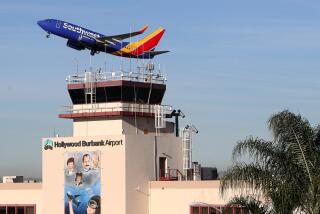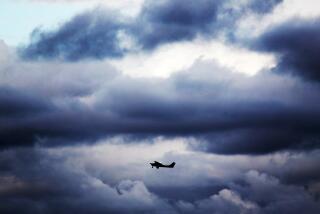FAA Cutting the Distance Between Jets
- Share via
A new policy instructing flight controllers to reduce the distance between jetliners on high-altitude flights from 20 miles to 10 miles will go into effect nationwide by the end of this month, federal officials said Saturday.
Federal Aviation Administration officials say the plan is an effort to cut down on flight delays, but critics contend that it invites disaster.
“The prescription for disasters and runway collisions is in the offing with this plan, and it increases the possibility of a Cerritos-type disaster,” said Anthony J. Skirlick Jr., president of the Los Angeles local of the National Air Traffic Controllers Assn., referring to the midair collision between an Aeromexico jetliner and a small plane last August that claimed 82 lives.
The effect of the policy will shrink the normal distance between commercial flights to 10 miles when they are flying above 18,000 feet, said Stephen Hayes, an FAA spokesman in Washington. The plan went into effect last week in the Southeastern region of the country, including Georgia, Florida, Kentucky, Tennessee, North Carolina, South Carolina and Puerto Rico; it will be phased in throughout the rest of the country, including Southern California, over the next several weeks.
The standard separation between high-flying aircraft differs among air traffic control centers, Hayes said. In the Southern California area, the so called “in-trail” distance between aircraft traveling on the same route at the same high altitude is usually between 15 and 20 miles.
‘No Adverse Effect’
“We are absolutely confident that this is going to have no adverse effect on safety,” Hayes said Saturday. “It is going to make the system, we believe, more efficient. . . . Safety is not being compromised at all.”
Hayes said that a 10-mile separation was common before the 1981 air traffic controllers’ strike. But after the strike, “primarily because of the shortage of air traffic controllers, there was a tendency to increase the horizontal distance between aircraft at high altitudes,” he said.
Senior FAA air traffic managers met in Houston two weeks ago with FAA Administrator Donald Engen to review air traffic control procedures and issues, Hayes said. The reduction was one result of that meeting.
Hayes called the 10-mile separation a “volume-controlling technique, a managing tool to meter the flow of traffic evenly.” In 1986, he said that an average of 1,144 flights were delayed daily nationwide.
Although this plan should cut down on such delays, most airline passengers will not see dramatic changes in overall airline performance, Hayes said.
Minimum Safety Standards
Hayes said the plan had nothing to do with minimum safety standards, which require aircraft flying up to 29,000 feet to be separated by five miles horizontally and 1,000 feet vertically. Planes flying over 29,000 feet must be separated by five miles horizontally and 2,000 feet vertically, he said.
But some air safety experts, pilots and air traffic controllers disagreed.
“It (the reduced separation plan) cuts down on the margin of safety,” said Barry Schiff, a TWA pilot who has written extensively on aircraft safety. “The FAA is attempting to reduce the safety margin to make up for a saturated system, and I’m not in favor of it.
“You have these margins to prevent accidents, and eventually you can get to the point where something’s going to happen,” Schiff said. “In this era of controller errors and understaffed control towers, I don’t think this is the time to reduce the safety margins.”
Dick Russell, Los Angeles-area safety coordinator for the Air Line Pilots Assn., said decreasing the distance between high-flying aircraft will put more planes in the sky and could increase the pressure on an already overburdened air traffic control system.
‘Require Additional Controllers’
“As the Air Line Pilots Assn. sees it, it is going to require additional controllers to handle the extra traffic,” Russell said. “Practically every FAA facility in the country is (already) understaffed.”
Transportation Secretary Elizabeth Hanford Dole last February asked Congress for more money to expand the nation’s aviation system and hire more air traffic controllers. In addition, a General Accounting Office study released last year noted the need for more controllers. With planes allowed to fly closer to each other, more planes will be flying and more will be forced into “airborne holding patterns” around airports before they can land, further complicating traffic in those areas, Russell said.
“It leaves less margin for error, and when you cut down that buffer margin, I guess you might say it perhaps might not be as safe,” Russell said.
Skirlick said that air traffic controllers are mandated to tell commercial airline pilots when small private planes, or “random traffic,” are in their airspace.
On the one hand, he said, the FAA plan will increase the number of commercial planes that controllers must track. On the other, “by having the controllers so busy with the (large, commercial) airplanes, it will reduce even further the ability to call this random traffic,” he said.
“That has been the one major problem in this airspace all along,” Skirlick said. “The collision at Cerritos was this exact same thing.”
More to Read
Inside the business of entertainment
The Wide Shot brings you news, analysis and insights on everything from streaming wars to production — and what it all means for the future.
You may occasionally receive promotional content from the Los Angeles Times.











